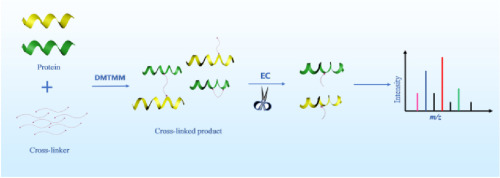Talanta ( IF 5.6 ) Pub Date : 2020-04-03 , DOI: 10.1016/j.talanta.2020.120964 Lili Cui 1 , Yongge Ma 2 , Ming Li 3 , Zhonglin Wei 1 , Yanfu Huan 1 , Qiang Fei 1 , Hongmei Li 3 , Lianyou Zheng 2

|
Cross-linking mass spectrometry (XL-MS) has attracted broad attention because of the capability to probe three-dimensional structure of proteins. Up to now, several amine-reactive cross-linkers have been developed for characterization of proteins and protein complexes. However, spatial information retrieved by XL-MS is still limited, partly because the strategies using an acidic residue reactive cross-linker have been rarely reported. In this paper, an acidic residue (e.g. aspartic acid, glutamic acid)-specific, disulfide bond-containing, cleavable cross-linker with a length of 13.1 Å, named 3,3′-dithiobis(propanoic dihydrazide), was presented for the first time. In addition, a novel approach using the cross-linker was proposed for unambiguous characterization of peptides and proteins with disulfide bonds. After cross-linked, the peptides could be electrochemically reduced, then characterized by high performance liquid chromatography mass spectrometry. For demonstration, the approach has been adopted to characterize the emideltide, insulin, and myoglobin, of which four pairs of intrachain cross-links have been successfully identified in myoglobin. The results showed that the cross-links displayed predictable fragmentation pattern upon collision induced dissociation (CID), thus admitting simplifying data analysis. In summary, this work introduces a novel type of cross-linker utilized for cross-linking and a new strategy to XL-MS technology for comprehensively understanding the three-dimensional structure of proteins.
中文翻译:

酸性残基反应性和含二硫键的可裂解交联剂,用于基于电化学质谱的蛋白质3D结构探测。
交联质谱(XL-MS)由于能够探测蛋白质的三维结构而备受关注。到目前为止,已经开发了几种胺反应性交联剂来表征蛋白质和蛋白质复合物。但是,通过XL-MS检索到的空间信息仍然受到限制,部分原因是很少报告使用酸性残基反应性交联剂的策略。本文提出了一种酸性残基(例如天冬氨酸,谷氨酸)特异性,含二硫键的可裂解交联剂,其长度为13.1Å,称为3,3'-dithiobis(propanic dihydrazide)。第一次。另外,提出了使用交联剂的新颖方法,用于具有二硫键的肽和蛋白质的明确表征。交联后 可以将肽进行电化学还原,然后通过高效液相色谱质谱法进行鉴定。为了证明这一点,已采用该方法来表征阿米特肽,胰岛素和肌红蛋白,其中在肌红蛋白中已成功鉴定出四对链内交联。结果表明,交联在碰撞诱导解离(CID)后显示出可预测的碎片模式,从而简化了数据分析。总而言之,这项工作介绍了一种用于交联的新型交联剂和一种用于XL-MS技术的新策略,以全面理解蛋白质的三维结构。该方法已被用来表征阿米特肽,胰岛素和肌红蛋白,其中四对链内交联已在肌红蛋白中成功鉴定。结果表明,交联在碰撞诱导解离(CID)后显示出可预测的碎片模式,从而简化了数据分析。总而言之,这项工作介绍了一种用于交联的新型交联剂和一种用于XL-MS技术的新策略,以全面理解蛋白质的三维结构。该方法已被用来表征阿米特肽,胰岛素和肌红蛋白,其中四对链内交联已在肌红蛋白中成功鉴定。结果表明,交联在碰撞诱导解离(CID)后显示出可预测的碎片模式,从而简化了数据分析。总而言之,这项工作介绍了一种用于交联的新型交联剂和一种用于XL-MS技术的新策略,以全面理解蛋白质的三维结构。因此可以简化数据分析。总而言之,这项工作介绍了一种用于交联的新型交联剂和一种用于XL-MS技术的新策略,以全面理解蛋白质的三维结构。因此可以简化数据分析。总而言之,这项工作介绍了一种用于交联的新型交联剂和一种用于XL-MS技术的新策略,以全面理解蛋白质的三维结构。











































 京公网安备 11010802027423号
京公网安备 11010802027423号